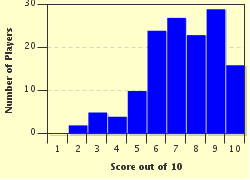Quiz Answer Key and Fun Facts
1. What did the Romans do to the city of Carthage when the siege ended in 146 BC?
2. What is the name of the fortress where the Jewish inhabitants all committed suicide rather than surrendering to the besieging Roman forces?
3. Whose first major military victory was the relief of Orleans during the Hundred Years' War?
4. The Siege of Candia in the 17th century is regarded as being the longest siege ever. For how many years did it last?
5. The siege of Badajoz in 1812 occurred during which conflict?
6. What nationality were the forces that besieged the Alamo in 1836 before launching an attack on the fort during which all the defenders were killed?
7. The year long Siege of Sevastopol (sometimes written as Sebastopol) took place during which 19th century war?
8. This fort was besieged twice during the US Civil War, the first time by Confederate forces in 1861 and the second by Union soldiers in 1863. What is it called?
9. Occurring in the Second Boer War, which siege made a national hero out of Robert Baden-Powell - the man who founded the Scouting movement?
10. One of the longest, deadliest and most destructive sieges in history was the Siege of Leningrad in World War II. How many days did it last?
Source: Author
HCR1
This quiz was reviewed by FunTrivia editor
bloomsby before going online.
Any errors found in FunTrivia content are routinely corrected through our feedback system.

